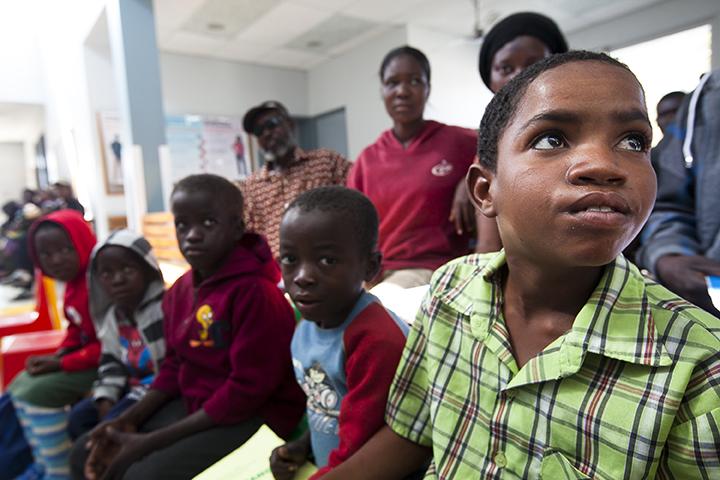Where We Work
See our interactive map



Just a few years ago, the waiting room in Shanamutango was permanently packed. Staff were stressed out and exhausted. The clinic had just one doctor and five nurses to care for over 10,000 clients per month. Photo by Trevor Snapp for IntraHealth International.
In remote northern Namibia, Onandjokwe Hospital is becoming a national model for bringing health care to people where they live.
Just a few years ago, if you’d visited northern Namibia’s Onandjokwe Hospital to, say, get a refill on your HIV meds, you’d have had to sit in line for an average of 8 or 9 hours.
“You had to wait for your name to be called at reception, then to have your BMI measured, then to have blood drawn, then HIV counseling, and then wait up to five hours at the pharmacy,” says nurse Ruusa Shipena, the ART (antiretroviral therapies) supervisor at Onandjokwe’s Shanamutango HIV clinic. People would turn up at the clinic the night before and sleep on the sidewalks just to be at the front of the line the next morning.
Shipena and her colleagues were seeing up to 80 clients per day—each.
The waiting room was permanently packed. Staff were stressed out and exhausted.
“Every day when you go home, your hands, your fingers, you have to—” nurse Shipena winces and makes a pained stretching motion. She and her colleagues were seeing up to 80 clients per day—each.
But today that number has dropped to around 40. The waiting room isn’t crowded. Things are running smoothly. And the few people who sit waiting in the reception area are called up within a few minutes of taking their seats, their entire visit now taking about an hour. The nurses are busy but calm as they talk with clients and smile at the visiting babies.
Two major reasons for Onandjokwe’s former overcrowding were: 1) it was the only place to get HIV-related services for over 81,000 people in a region that suffers high rates of HIV infection (reaching 22.6% in Onandjokwe district); and 2) it was severely short on staff.
In 2012, the Shanamutango clinic had just one doctor and five nurses to care for over 10,000 clients per month.
But IntraHealth International is helping Onandjokwe solve its staff shortage by recruiting additional nurses, health assistants, administrative staff, and drivers. In all, IntraHealth’s USAID HIV Clinical Services Technical Assistance Project has helped add 42 new health workers to the region through its rapid hiring approach.
“We now have more time to spend with our clients,” Shipena says. “They are very happy with that.”
And the additional resources and hands on deck have allowed Onandjokwe to staff satellite facilities and establish points of care within the communities. Supported by USAID through PEPFAR, IntraHealth has now helped it decentralize ART services to eight clinics throughout the district.
The result: Onandjokwe is now number one in the country for decentralization—that is, making services available beyond the central hospital location. It’s become a model for providing high-quality care to remote populations that are spread out over vast geographic areas. And best of all, people who live far from the hospital no longer have to walk for days or spend precious money on transport to get the care they need.
Now we can do a lot. We can plan our community outreach.
“Now the mothers who used to come get their services here, they have started going to clinics that are closer to where they live,” Shipena says. “That’s why you can see it’s so empty in the waiting room.”
IntraHealth also set up ART services at 20 of the hospital’s 45 community outreach points, which provide general care to communities in the district. Before the newly hired drivers and donated cars were available, Shipena and her staff could only provide outreach services when the opportunity struck.
“If there’s no car, and the community’s waiting on you to deliver the services—” Shipena shrugs. “Sometimes you end up suspending some of the services. But now we can do a lot. We can go on our own time, we can plan our community outreach.” She and her staff visit each of the 20 sites every month, providing not only ART services but also immunizations and HIV testing.
“Yesterday we went to the farthest outreach point, 133 kilometers from Onandjokwe,” she says. “Patients were telling us that in the past, they had to wake up at two in the morning to walk through the bush, just to get their HIV meds. Now—they’re happy.”
IntraHealth is working with the government of Namibia to increase the number of health workers providing HIV services and provide the support and training they need to reach the country’s goal of an AIDS-free generation. IntraHealth’s USAID HIV Clinical Services Technical Assistance Project in Namibia is funded by the US Agency for International Development through the President’s Emergency Plan for AIDS Response (PEPFAR). Read more about IntraHealth’s work in Namibia.
Valery Mwashekele and Cherizaan Willemse contributed reporting to this story.
This post originally appeared on the Huffington Post.
Get the latest updates from the blog and eNews




